Brand Management Report: Cadbury Case Study, Marketing Strategies
VerifiedAdded on 2023/01/11
|14
|4605
|25
Report
AI Summary
This report provides a comprehensive analysis of brand management, utilizing Cadbury as a central case study. It begins with an introduction to brand management as a crucial marketing tool, exploring its uses and benefits in business practice, with a specific focus on Cadbury's global presence and product offerings. The report then delves into the key components of a successful brand strategy, including brand identity, brand value, and customer loyalty, examining the 'Brand Value Plan' by Aaker and its elements. The analysis extends to portfolio management strategies, brand hierarchy, and equity management, differentiating between branded house, umbrella, and brand house approaches, as implemented by Cadbury. Furthermore, the report evaluates how brands are managed in partnership at both domestic and global levels, assessing the impact of these strategies. Finally, it explores various techniques for measuring and managing brand value, concluding with a summary of the findings and their implications for effective brand management within the context of a global organization like Cadbury.

Brand Management
Paraphrase This Document
Need a fresh take? Get an instant paraphrase of this document with our AI Paraphraser
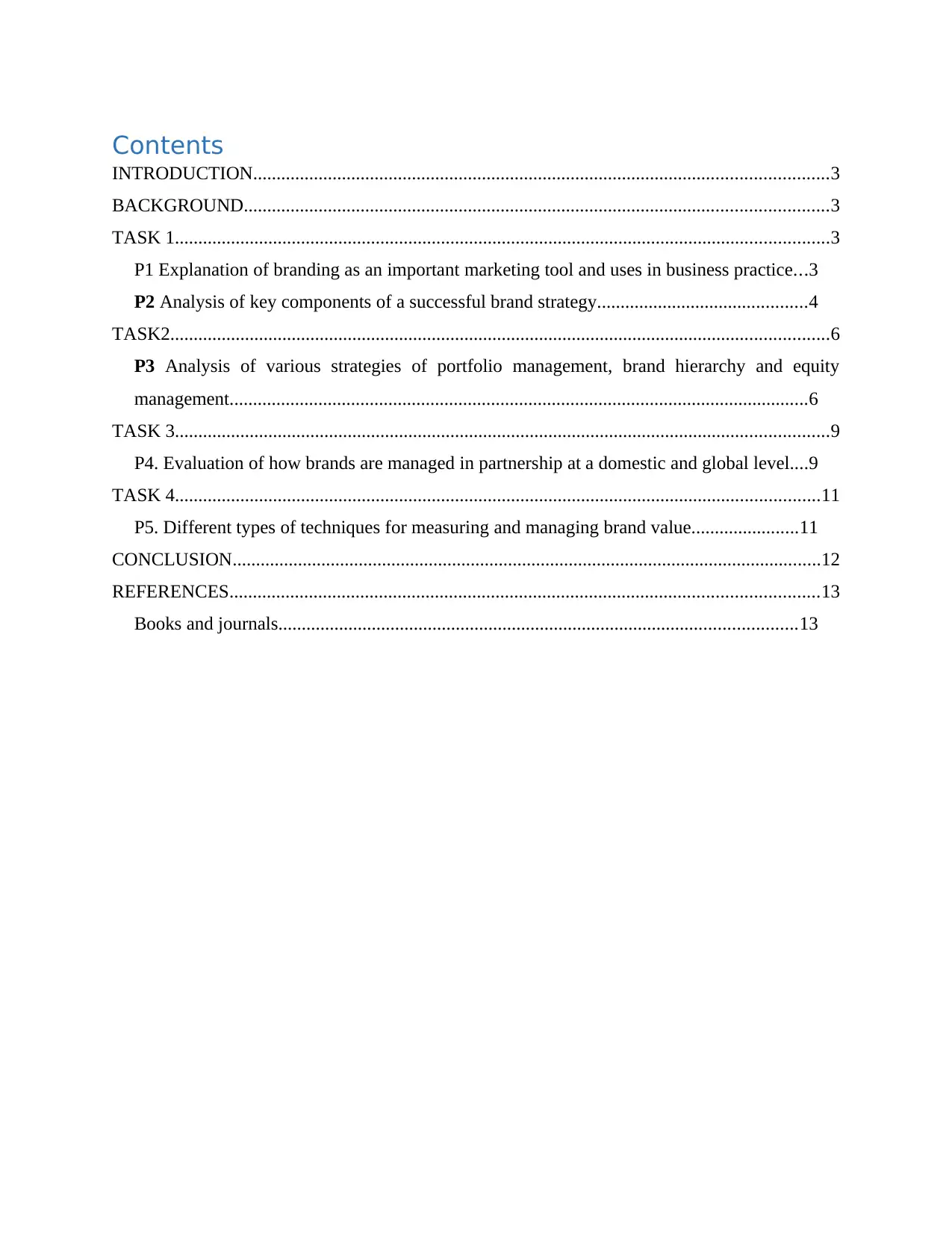
Contents
INTRODUCTION...........................................................................................................................3
BACKGROUND.............................................................................................................................3
TASK 1............................................................................................................................................3
P1 Explanation of branding as an important marketing tool and uses in business practice...3
P2 Analysis of key components of a successful brand strategy.............................................4
TASK2.............................................................................................................................................6
P3 Analysis of various strategies of portfolio management, brand hierarchy and equity
management............................................................................................................................6
TASK 3............................................................................................................................................9
P4. Evaluation of how brands are managed in partnership at a domestic and global level....9
TASK 4..........................................................................................................................................11
P5. Different types of techniques for measuring and managing brand value.......................11
CONCLUSION..............................................................................................................................12
REFERENCES..............................................................................................................................13
Books and journals...............................................................................................................13
INTRODUCTION...........................................................................................................................3
BACKGROUND.............................................................................................................................3
TASK 1............................................................................................................................................3
P1 Explanation of branding as an important marketing tool and uses in business practice...3
P2 Analysis of key components of a successful brand strategy.............................................4
TASK2.............................................................................................................................................6
P3 Analysis of various strategies of portfolio management, brand hierarchy and equity
management............................................................................................................................6
TASK 3............................................................................................................................................9
P4. Evaluation of how brands are managed in partnership at a domestic and global level....9
TASK 4..........................................................................................................................................11
P5. Different types of techniques for measuring and managing brand value.......................11
CONCLUSION..............................................................................................................................12
REFERENCES..............................................................................................................................13
Books and journals...............................................................................................................13
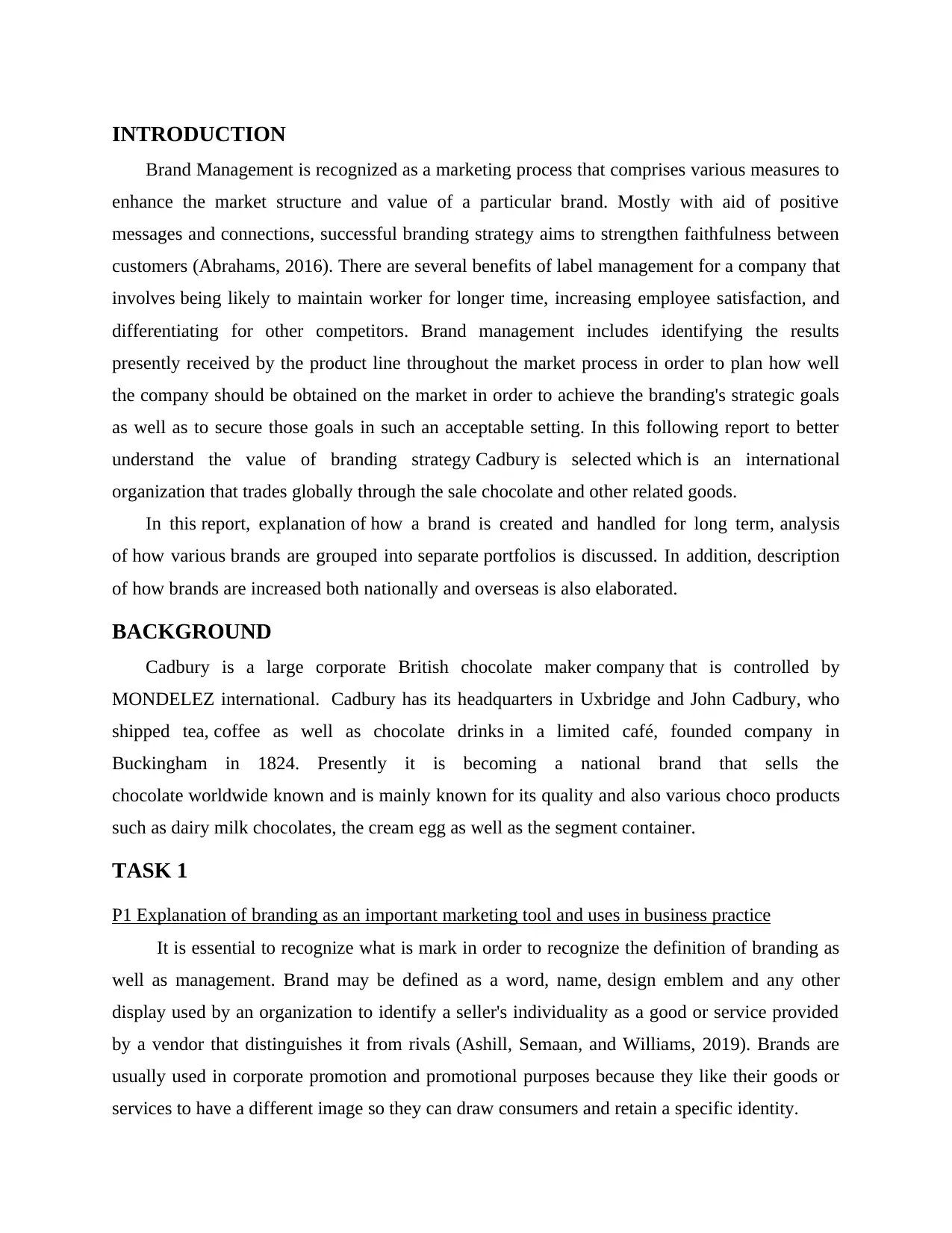
INTRODUCTION
Brand Management is recognized as a marketing process that comprises various measures to
enhance the market structure and value of a particular brand. Mostly with aid of positive
messages and connections, successful branding strategy aims to strengthen faithfulness between
customers (Abrahams, 2016). There are several benefits of label management for a company that
involves being likely to maintain worker for longer time, increasing employee satisfaction, and
differentiating for other competitors. Brand management includes identifying the results
presently received by the product line throughout the market process in order to plan how well
the company should be obtained on the market in order to achieve the branding's strategic goals
as well as to secure those goals in such an acceptable setting. In this following report to better
understand the value of branding strategy Cadbury is selected which is an international
organization that trades globally through the sale chocolate and other related goods.
In this report, explanation of how a brand is created and handled for long term, analysis
of how various brands are grouped into separate portfolios is discussed. In addition, description
of how brands are increased both nationally and overseas is also elaborated.
BACKGROUND
Cadbury is a large corporate British chocolate maker company that is controlled by
MONDELEZ international. Cadbury has its headquarters in Uxbridge and John Cadbury, who
shipped tea, coffee as well as chocolate drinks in a limited café, founded company in
Buckingham in 1824. Presently it is becoming a national brand that sells the
chocolate worldwide known and is mainly known for its quality and also various choco products
such as dairy milk chocolates, the cream egg as well as the segment container.
TASK 1
P1 Explanation of branding as an important marketing tool and uses in business practice
It is essential to recognize what is mark in order to recognize the definition of branding as
well as management. Brand may be defined as a word, name, design emblem and any other
display used by an organization to identify a seller's individuality as a good or service provided
by a vendor that distinguishes it from rivals (Ashill, Semaan, and Williams, 2019). Brands are
usually used in corporate promotion and promotional purposes because they like their goods or
services to have a different image so they can draw consumers and retain a specific identity.
Brand Management is recognized as a marketing process that comprises various measures to
enhance the market structure and value of a particular brand. Mostly with aid of positive
messages and connections, successful branding strategy aims to strengthen faithfulness between
customers (Abrahams, 2016). There are several benefits of label management for a company that
involves being likely to maintain worker for longer time, increasing employee satisfaction, and
differentiating for other competitors. Brand management includes identifying the results
presently received by the product line throughout the market process in order to plan how well
the company should be obtained on the market in order to achieve the branding's strategic goals
as well as to secure those goals in such an acceptable setting. In this following report to better
understand the value of branding strategy Cadbury is selected which is an international
organization that trades globally through the sale chocolate and other related goods.
In this report, explanation of how a brand is created and handled for long term, analysis
of how various brands are grouped into separate portfolios is discussed. In addition, description
of how brands are increased both nationally and overseas is also elaborated.
BACKGROUND
Cadbury is a large corporate British chocolate maker company that is controlled by
MONDELEZ international. Cadbury has its headquarters in Uxbridge and John Cadbury, who
shipped tea, coffee as well as chocolate drinks in a limited café, founded company in
Buckingham in 1824. Presently it is becoming a national brand that sells the
chocolate worldwide known and is mainly known for its quality and also various choco products
such as dairy milk chocolates, the cream egg as well as the segment container.
TASK 1
P1 Explanation of branding as an important marketing tool and uses in business practice
It is essential to recognize what is mark in order to recognize the definition of branding as
well as management. Brand may be defined as a word, name, design emblem and any other
display used by an organization to identify a seller's individuality as a good or service provided
by a vendor that distinguishes it from rivals (Ashill, Semaan, and Williams, 2019). Brands are
usually used in corporate promotion and promotional purposes because they like their goods or
services to have a different image so they can draw consumers and retain a specific identity.
⊘ This is a preview!⊘
Do you want full access?
Subscribe today to unlock all pages.

Trusted by 1+ million students worldwide
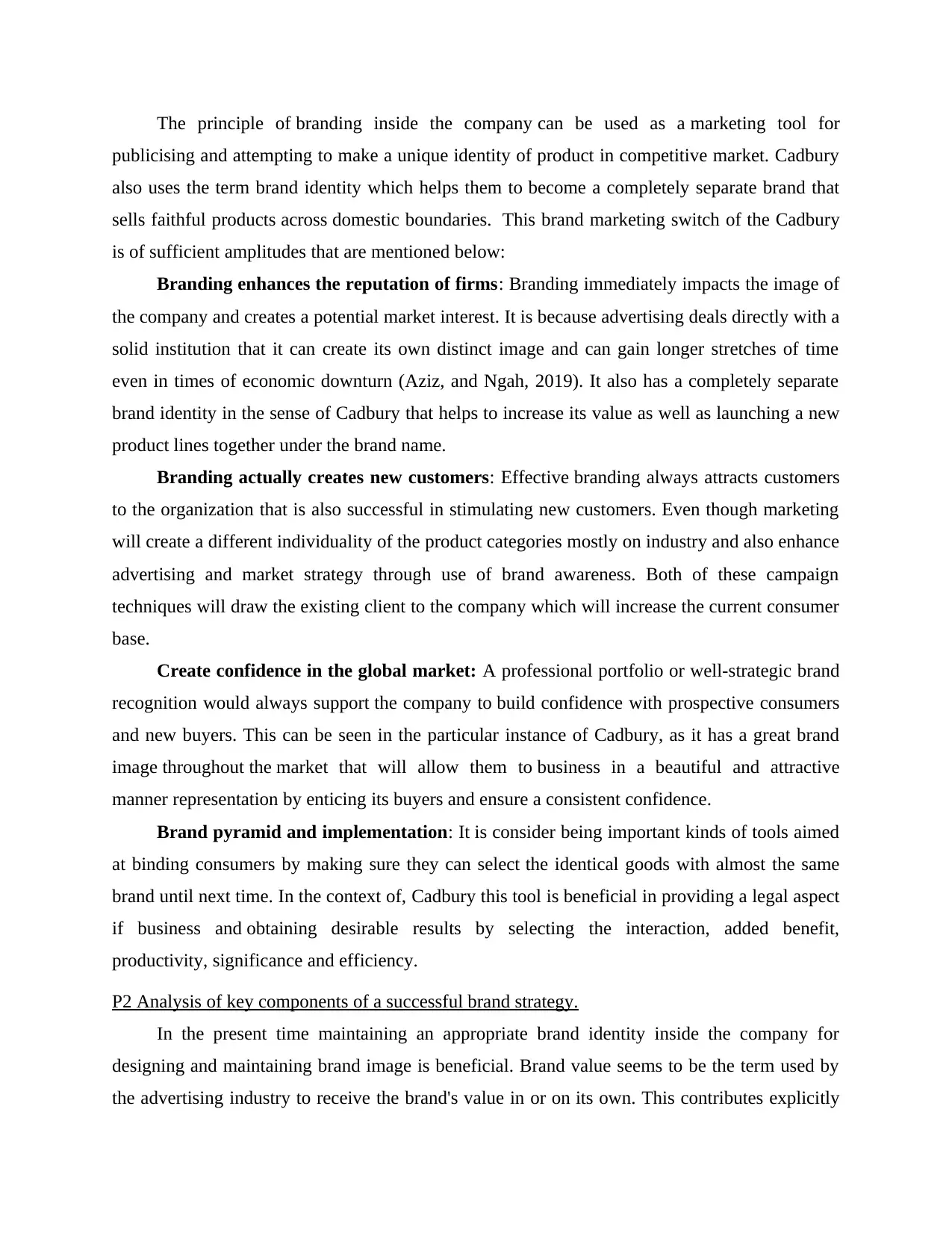
The principle of branding inside the company can be used as a marketing tool for
publicising and attempting to make a unique identity of product in competitive market. Cadbury
also uses the term brand identity which helps them to become a completely separate brand that
sells faithful products across domestic boundaries. This brand marketing switch of the Cadbury
is of sufficient amplitudes that are mentioned below:
Branding enhances the reputation of firms: Branding immediately impacts the image of
the company and creates a potential market interest. It is because advertising deals directly with a
solid institution that it can create its own distinct image and can gain longer stretches of time
even in times of economic downturn (Aziz, and Ngah, 2019). It also has a completely separate
brand identity in the sense of Cadbury that helps to increase its value as well as launching a new
product lines together under the brand name.
Branding actually creates new customers: Effective branding always attracts customers
to the organization that is also successful in stimulating new customers. Even though marketing
will create a different individuality of the product categories mostly on industry and also enhance
advertising and market strategy through use of brand awareness. Both of these campaign
techniques will draw the existing client to the company which will increase the current consumer
base.
Create confidence in the global market: A professional portfolio or well-strategic brand
recognition would always support the company to build confidence with prospective consumers
and new buyers. This can be seen in the particular instance of Cadbury, as it has a great brand
image throughout the market that will allow them to business in a beautiful and attractive
manner representation by enticing its buyers and ensure a consistent confidence.
Brand pyramid and implementation: It is consider being important kinds of tools aimed
at binding consumers by making sure they can select the identical goods with almost the same
brand until next time. In the context of, Cadbury this tool is beneficial in providing a legal aspect
if business and obtaining desirable results by selecting the interaction, added benefit,
productivity, significance and efficiency.
P2 Analysis of key components of a successful brand strategy.
In the present time maintaining an appropriate brand identity inside the company for
designing and maintaining brand image is beneficial. Brand value seems to be the term used by
the advertising industry to receive the brand's value in or on its own. This contributes explicitly
publicising and attempting to make a unique identity of product in competitive market. Cadbury
also uses the term brand identity which helps them to become a completely separate brand that
sells faithful products across domestic boundaries. This brand marketing switch of the Cadbury
is of sufficient amplitudes that are mentioned below:
Branding enhances the reputation of firms: Branding immediately impacts the image of
the company and creates a potential market interest. It is because advertising deals directly with a
solid institution that it can create its own distinct image and can gain longer stretches of time
even in times of economic downturn (Aziz, and Ngah, 2019). It also has a completely separate
brand identity in the sense of Cadbury that helps to increase its value as well as launching a new
product lines together under the brand name.
Branding actually creates new customers: Effective branding always attracts customers
to the organization that is also successful in stimulating new customers. Even though marketing
will create a different individuality of the product categories mostly on industry and also enhance
advertising and market strategy through use of brand awareness. Both of these campaign
techniques will draw the existing client to the company which will increase the current consumer
base.
Create confidence in the global market: A professional portfolio or well-strategic brand
recognition would always support the company to build confidence with prospective consumers
and new buyers. This can be seen in the particular instance of Cadbury, as it has a great brand
image throughout the market that will allow them to business in a beautiful and attractive
manner representation by enticing its buyers and ensure a consistent confidence.
Brand pyramid and implementation: It is consider being important kinds of tools aimed
at binding consumers by making sure they can select the identical goods with almost the same
brand until next time. In the context of, Cadbury this tool is beneficial in providing a legal aspect
if business and obtaining desirable results by selecting the interaction, added benefit,
productivity, significance and efficiency.
P2 Analysis of key components of a successful brand strategy.
In the present time maintaining an appropriate brand identity inside the company for
designing and maintaining brand image is beneficial. Brand value seems to be the term used by
the advertising industry to receive the brand's value in or on its own. This contributes explicitly
Paraphrase This Document
Need a fresh take? Get an instant paraphrase of this document with our AI Paraphraser
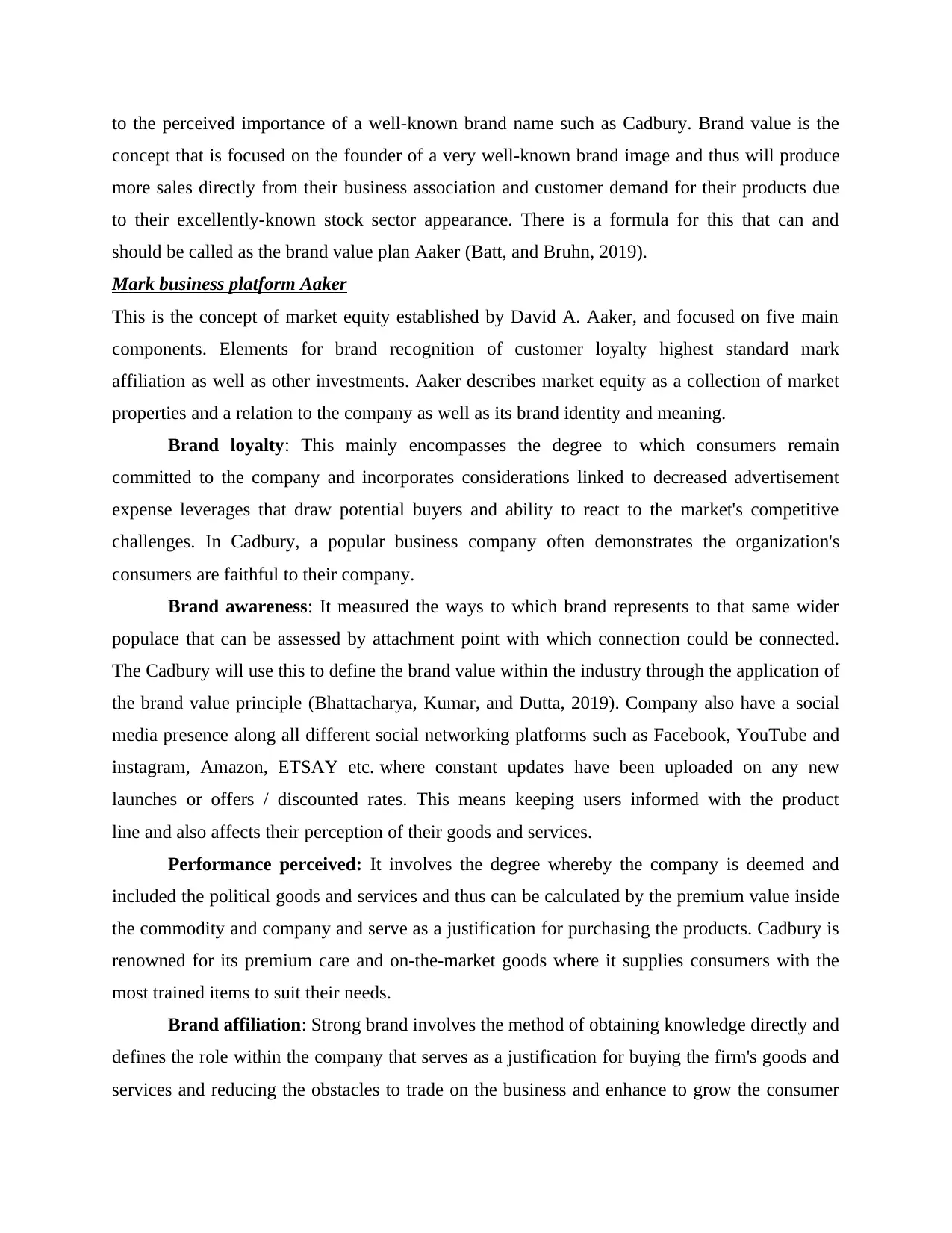
to the perceived importance of a well-known brand name such as Cadbury. Brand value is the
concept that is focused on the founder of a very well-known brand image and thus will produce
more sales directly from their business association and customer demand for their products due
to their excellently-known stock sector appearance. There is a formula for this that can and
should be called as the brand value plan Aaker (Batt, and Bruhn, 2019).
Mark business platform Aaker
This is the concept of market equity established by David A. Aaker, and focused on five main
components. Elements for brand recognition of customer loyalty highest standard mark
affiliation as well as other investments. Aaker describes market equity as a collection of market
properties and a relation to the company as well as its brand identity and meaning.
Brand loyalty: This mainly encompasses the degree to which consumers remain
committed to the company and incorporates considerations linked to decreased advertisement
expense leverages that draw potential buyers and ability to react to the market's competitive
challenges. In Cadbury, a popular business company often demonstrates the organization's
consumers are faithful to their company.
Brand awareness: It measured the ways to which brand represents to that same wider
populace that can be assessed by attachment point with which connection could be connected.
The Cadbury will use this to define the brand value within the industry through the application of
the brand value principle (Bhattacharya, Kumar, and Dutta, 2019). Company also have a social
media presence along all different social networking platforms such as Facebook, YouTube and
instagram, Amazon, ETSAY etc. where constant updates have been uploaded on any new
launches or offers / discounted rates. This means keeping users informed with the product
line and also affects their perception of their goods and services.
Performance perceived: It involves the degree whereby the company is deemed and
included the political goods and services and thus can be calculated by the premium value inside
the commodity and company and serve as a justification for purchasing the products. Cadbury is
renowned for its premium care and on-the-market goods where it supplies consumers with the
most trained items to suit their needs.
Brand affiliation: Strong brand involves the method of obtaining knowledge directly and
defines the role within the company that serves as a justification for buying the firm's goods and
services and reducing the obstacles to trade on the business and enhance to grow the consumer
concept that is focused on the founder of a very well-known brand image and thus will produce
more sales directly from their business association and customer demand for their products due
to their excellently-known stock sector appearance. There is a formula for this that can and
should be called as the brand value plan Aaker (Batt, and Bruhn, 2019).
Mark business platform Aaker
This is the concept of market equity established by David A. Aaker, and focused on five main
components. Elements for brand recognition of customer loyalty highest standard mark
affiliation as well as other investments. Aaker describes market equity as a collection of market
properties and a relation to the company as well as its brand identity and meaning.
Brand loyalty: This mainly encompasses the degree to which consumers remain
committed to the company and incorporates considerations linked to decreased advertisement
expense leverages that draw potential buyers and ability to react to the market's competitive
challenges. In Cadbury, a popular business company often demonstrates the organization's
consumers are faithful to their company.
Brand awareness: It measured the ways to which brand represents to that same wider
populace that can be assessed by attachment point with which connection could be connected.
The Cadbury will use this to define the brand value within the industry through the application of
the brand value principle (Bhattacharya, Kumar, and Dutta, 2019). Company also have a social
media presence along all different social networking platforms such as Facebook, YouTube and
instagram, Amazon, ETSAY etc. where constant updates have been uploaded on any new
launches or offers / discounted rates. This means keeping users informed with the product
line and also affects their perception of their goods and services.
Performance perceived: It involves the degree whereby the company is deemed and
included the political goods and services and thus can be calculated by the premium value inside
the commodity and company and serve as a justification for purchasing the products. Cadbury is
renowned for its premium care and on-the-market goods where it supplies consumers with the
most trained items to suit their needs.
Brand affiliation: Strong brand involves the method of obtaining knowledge directly and
defines the role within the company that serves as a justification for buying the firm's goods and
services and reducing the obstacles to trade on the business and enhance to grow the consumer
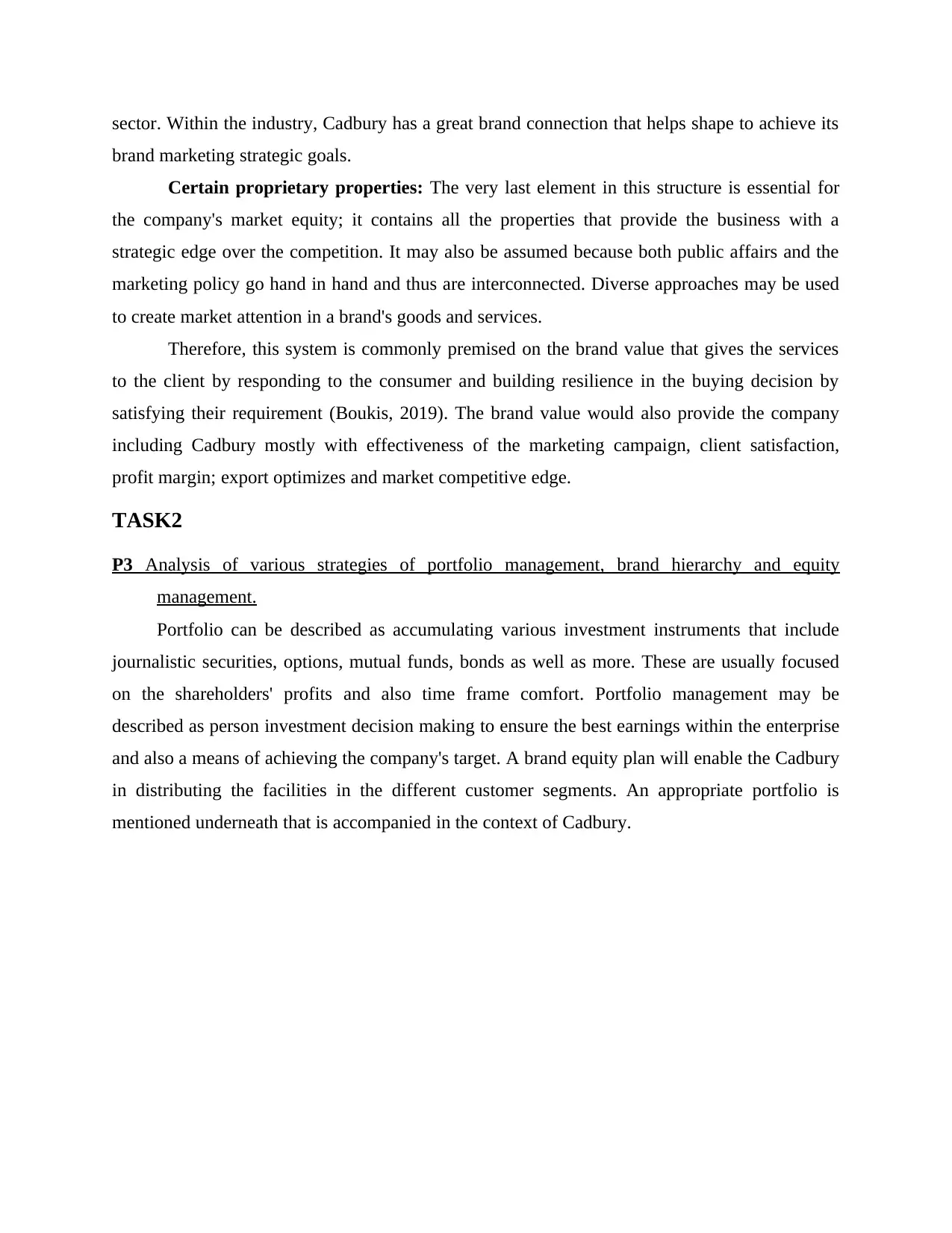
sector. Within the industry, Cadbury has a great brand connection that helps shape to achieve its
brand marketing strategic goals.
Certain proprietary properties: The very last element in this structure is essential for
the company's market equity; it contains all the properties that provide the business with a
strategic edge over the competition. It may also be assumed because both public affairs and the
marketing policy go hand in hand and thus are interconnected. Diverse approaches may be used
to create market attention in a brand's goods and services.
Therefore, this system is commonly premised on the brand value that gives the services
to the client by responding to the consumer and building resilience in the buying decision by
satisfying their requirement (Boukis, 2019). The brand value would also provide the company
including Cadbury mostly with effectiveness of the marketing campaign, client satisfaction,
profit margin; export optimizes and market competitive edge.
TASK2
P3 Analysis of various strategies of portfolio management, brand hierarchy and equity
management.
Portfolio can be described as accumulating various investment instruments that include
journalistic securities, options, mutual funds, bonds as well as more. These are usually focused
on the shareholders' profits and also time frame comfort. Portfolio management may be
described as person investment decision making to ensure the best earnings within the enterprise
and also a means of achieving the company's target. A brand equity plan will enable the Cadbury
in distributing the facilities in the different customer segments. An appropriate portfolio is
mentioned underneath that is accompanied in the context of Cadbury.
brand marketing strategic goals.
Certain proprietary properties: The very last element in this structure is essential for
the company's market equity; it contains all the properties that provide the business with a
strategic edge over the competition. It may also be assumed because both public affairs and the
marketing policy go hand in hand and thus are interconnected. Diverse approaches may be used
to create market attention in a brand's goods and services.
Therefore, this system is commonly premised on the brand value that gives the services
to the client by responding to the consumer and building resilience in the buying decision by
satisfying their requirement (Boukis, 2019). The brand value would also provide the company
including Cadbury mostly with effectiveness of the marketing campaign, client satisfaction,
profit margin; export optimizes and market competitive edge.
TASK2
P3 Analysis of various strategies of portfolio management, brand hierarchy and equity
management.
Portfolio can be described as accumulating various investment instruments that include
journalistic securities, options, mutual funds, bonds as well as more. These are usually focused
on the shareholders' profits and also time frame comfort. Portfolio management may be
described as person investment decision making to ensure the best earnings within the enterprise
and also a means of achieving the company's target. A brand equity plan will enable the Cadbury
in distributing the facilities in the different customer segments. An appropriate portfolio is
mentioned underneath that is accompanied in the context of Cadbury.
⊘ This is a preview!⊘
Do you want full access?
Subscribe today to unlock all pages.

Trusted by 1+ million students worldwide
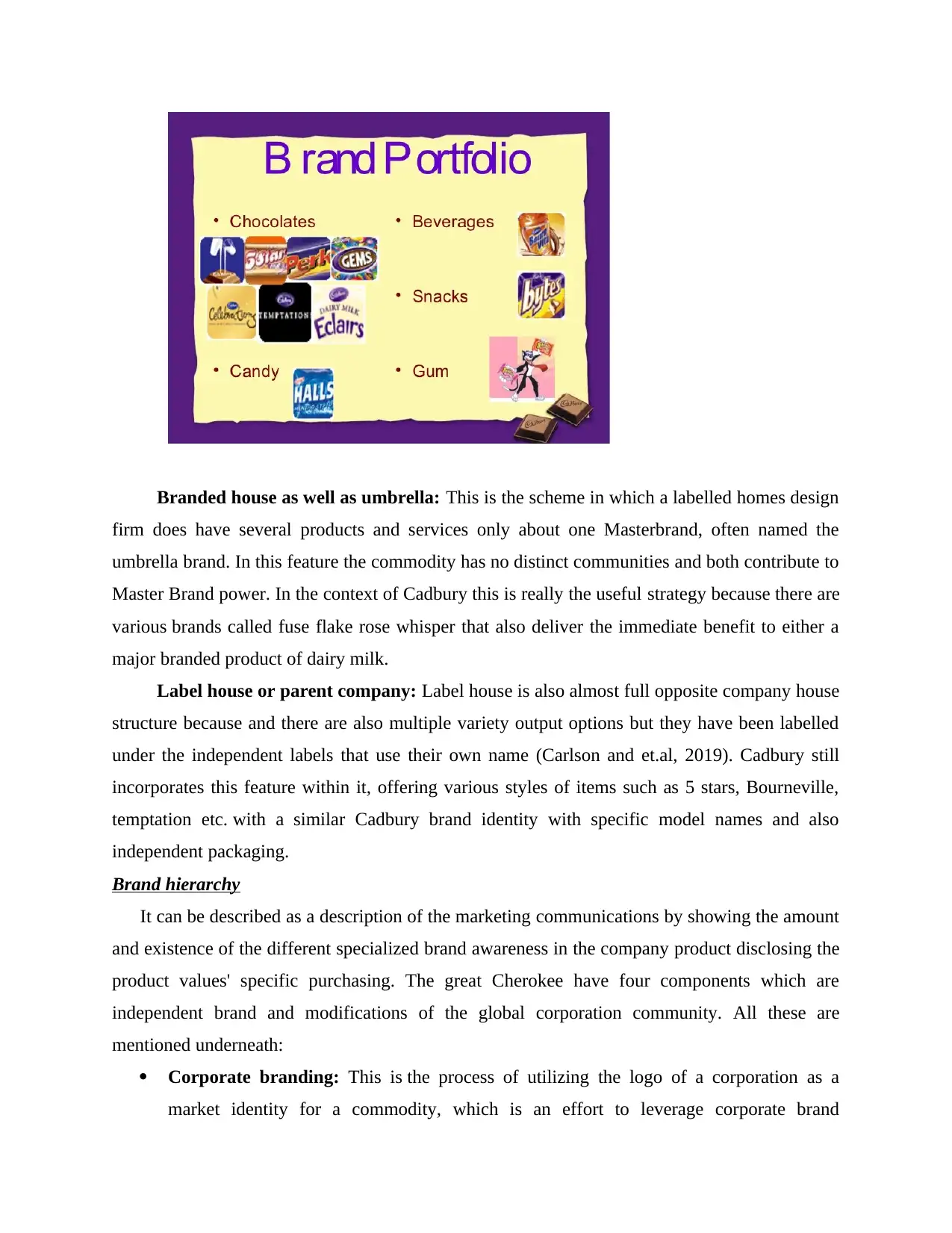
Branded house as well as umbrella: This is the scheme in which a labelled homes design
firm does have several products and services only about one Masterbrand, often named the
umbrella brand. In this feature the commodity has no distinct communities and both contribute to
Master Brand power. In the context of Cadbury this is really the useful strategy because there are
various brands called fuse flake rose whisper that also deliver the immediate benefit to either a
major branded product of dairy milk.
Label house or parent company: Label house is also almost full opposite company house
structure because and there are also multiple variety output options but they have been labelled
under the independent labels that use their own name (Carlson and et.al, 2019). Cadbury still
incorporates this feature within it, offering various styles of items such as 5 stars, Bourneville,
temptation etc. with a similar Cadbury brand identity with specific model names and also
independent packaging.
Brand hierarchy
It can be described as a description of the marketing communications by showing the amount
and existence of the different specialized brand awareness in the company product disclosing the
product values' specific purchasing. The great Cherokee have four components which are
independent brand and modifications of the global corporation community. All these are
mentioned underneath:
Corporate branding: This is the process of utilizing the logo of a corporation as a
market identity for a commodity, which is an effort to leverage corporate brand
firm does have several products and services only about one Masterbrand, often named the
umbrella brand. In this feature the commodity has no distinct communities and both contribute to
Master Brand power. In the context of Cadbury this is really the useful strategy because there are
various brands called fuse flake rose whisper that also deliver the immediate benefit to either a
major branded product of dairy milk.
Label house or parent company: Label house is also almost full opposite company house
structure because and there are also multiple variety output options but they have been labelled
under the independent labels that use their own name (Carlson and et.al, 2019). Cadbury still
incorporates this feature within it, offering various styles of items such as 5 stars, Bourneville,
temptation etc. with a similar Cadbury brand identity with specific model names and also
independent packaging.
Brand hierarchy
It can be described as a description of the marketing communications by showing the amount
and existence of the different specialized brand awareness in the company product disclosing the
product values' specific purchasing. The great Cherokee have four components which are
independent brand and modifications of the global corporation community. All these are
mentioned underneath:
Corporate branding: This is the process of utilizing the logo of a corporation as a
market identity for a commodity, which is an effort to leverage corporate brand
Paraphrase This Document
Need a fresh take? Get an instant paraphrase of this document with our AI Paraphraser
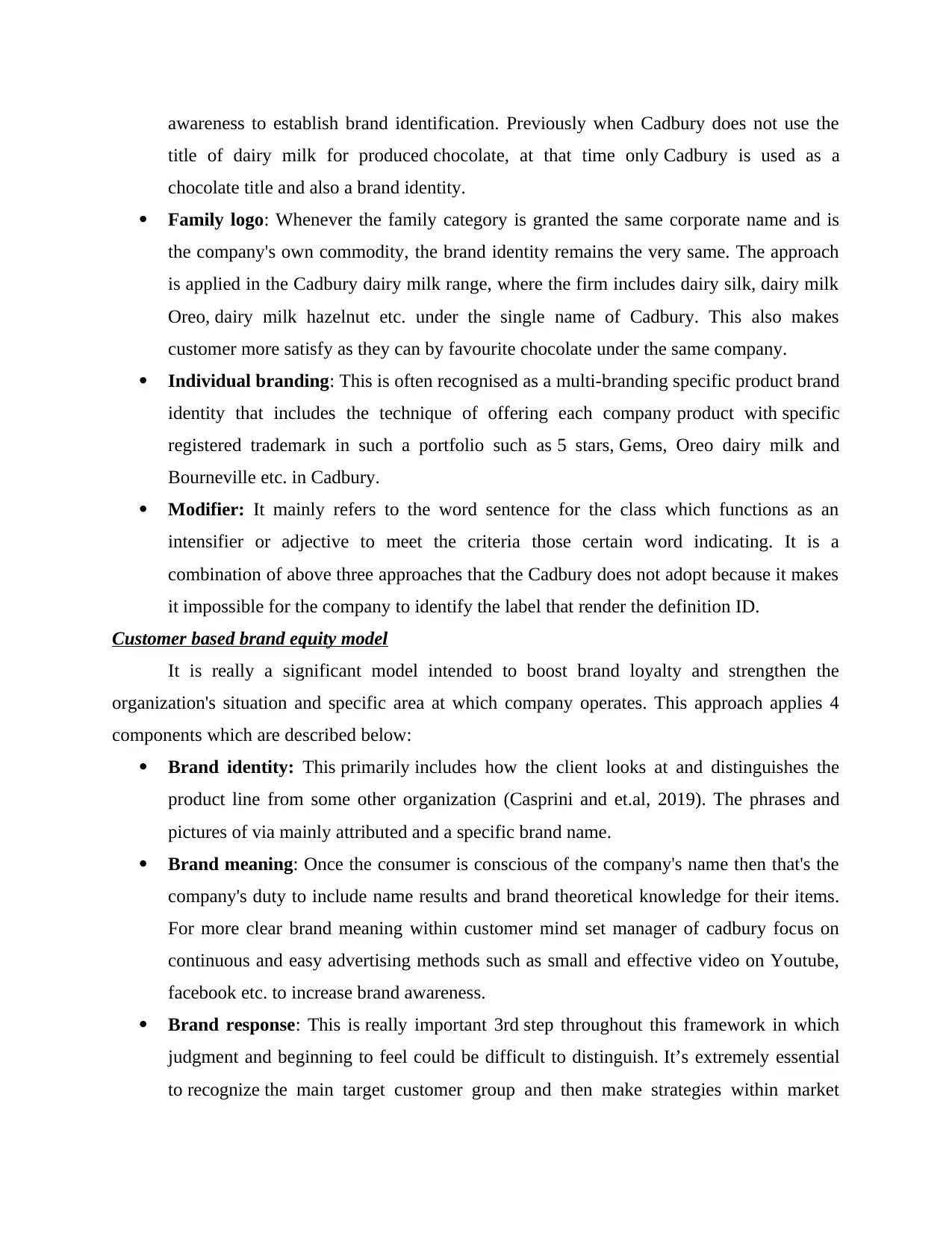
awareness to establish brand identification. Previously when Cadbury does not use the
title of dairy milk for produced chocolate, at that time only Cadbury is used as a
chocolate title and also a brand identity.
Family logo: Whenever the family category is granted the same corporate name and is
the company's own commodity, the brand identity remains the very same. The approach
is applied in the Cadbury dairy milk range, where the firm includes dairy silk, dairy milk
Oreo, dairy milk hazelnut etc. under the single name of Cadbury. This also makes
customer more satisfy as they can by favourite chocolate under the same company.
Individual branding: This is often recognised as a multi-branding specific product brand
identity that includes the technique of offering each company product with specific
registered trademark in such a portfolio such as 5 stars, Gems, Oreo dairy milk and
Bourneville etc. in Cadbury.
Modifier: It mainly refers to the word sentence for the class which functions as an
intensifier or adjective to meet the criteria those certain word indicating. It is a
combination of above three approaches that the Cadbury does not adopt because it makes
it impossible for the company to identify the label that render the definition ID.
Customer based brand equity model
It is really a significant model intended to boost brand loyalty and strengthen the
organization's situation and specific area at which company operates. This approach applies 4
components which are described below:
Brand identity: This primarily includes how the client looks at and distinguishes the
product line from some other organization (Casprini and et.al, 2019). The phrases and
pictures of via mainly attributed and a specific brand name.
Brand meaning: Once the consumer is conscious of the company's name then that's the
company's duty to include name results and brand theoretical knowledge for their items.
For more clear brand meaning within customer mind set manager of cadbury focus on
continuous and easy advertising methods such as small and effective video on Youtube,
facebook etc. to increase brand awareness.
Brand response: This is really important 3rd step throughout this framework in which
judgment and beginning to feel could be difficult to distinguish. It’s extremely essential
to recognize the main target customer group and then make strategies within market
title of dairy milk for produced chocolate, at that time only Cadbury is used as a
chocolate title and also a brand identity.
Family logo: Whenever the family category is granted the same corporate name and is
the company's own commodity, the brand identity remains the very same. The approach
is applied in the Cadbury dairy milk range, where the firm includes dairy silk, dairy milk
Oreo, dairy milk hazelnut etc. under the single name of Cadbury. This also makes
customer more satisfy as they can by favourite chocolate under the same company.
Individual branding: This is often recognised as a multi-branding specific product brand
identity that includes the technique of offering each company product with specific
registered trademark in such a portfolio such as 5 stars, Gems, Oreo dairy milk and
Bourneville etc. in Cadbury.
Modifier: It mainly refers to the word sentence for the class which functions as an
intensifier or adjective to meet the criteria those certain word indicating. It is a
combination of above three approaches that the Cadbury does not adopt because it makes
it impossible for the company to identify the label that render the definition ID.
Customer based brand equity model
It is really a significant model intended to boost brand loyalty and strengthen the
organization's situation and specific area at which company operates. This approach applies 4
components which are described below:
Brand identity: This primarily includes how the client looks at and distinguishes the
product line from some other organization (Casprini and et.al, 2019). The phrases and
pictures of via mainly attributed and a specific brand name.
Brand meaning: Once the consumer is conscious of the company's name then that's the
company's duty to include name results and brand theoretical knowledge for their items.
For more clear brand meaning within customer mind set manager of cadbury focus on
continuous and easy advertising methods such as small and effective video on Youtube,
facebook etc. to increase brand awareness.
Brand response: This is really important 3rd step throughout this framework in which
judgment and beginning to feel could be difficult to distinguish. It’s extremely essential
to recognize the main target customer group and then make strategies within market
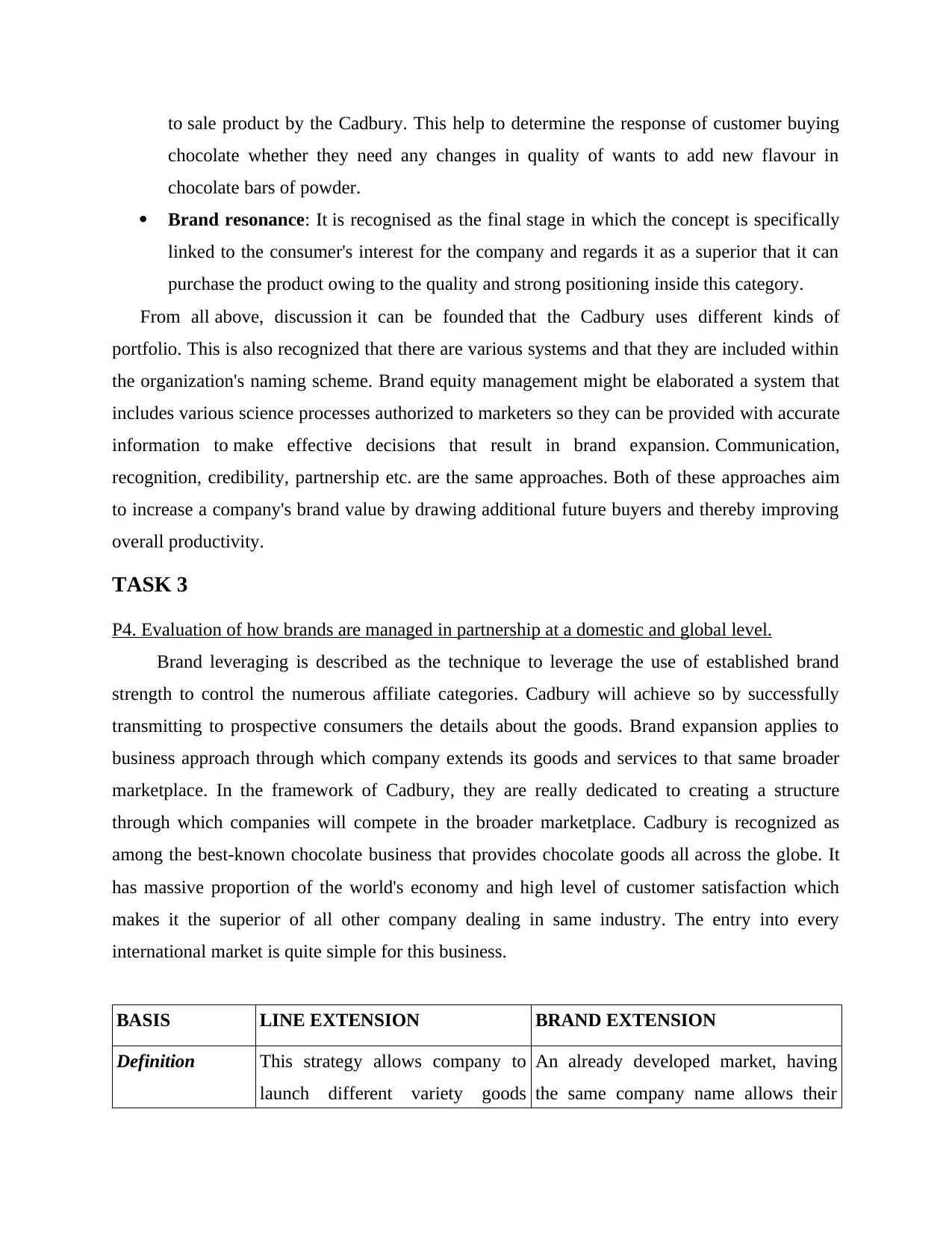
to sale product by the Cadbury. This help to determine the response of customer buying
chocolate whether they need any changes in quality of wants to add new flavour in
chocolate bars of powder.
Brand resonance: It is recognised as the final stage in which the concept is specifically
linked to the consumer's interest for the company and regards it as a superior that it can
purchase the product owing to the quality and strong positioning inside this category.
From all above, discussion it can be founded that the Cadbury uses different kinds of
portfolio. This is also recognized that there are various systems and that they are included within
the organization's naming scheme. Brand equity management might be elaborated a system that
includes various science processes authorized to marketers so they can be provided with accurate
information to make effective decisions that result in brand expansion. Communication,
recognition, credibility, partnership etc. are the same approaches. Both of these approaches aim
to increase a company's brand value by drawing additional future buyers and thereby improving
overall productivity.
TASK 3
P4. Evaluation of how brands are managed in partnership at a domestic and global level.
Brand leveraging is described as the technique to leverage the use of established brand
strength to control the numerous affiliate categories. Cadbury will achieve so by successfully
transmitting to prospective consumers the details about the goods. Brand expansion applies to
business approach through which company extends its goods and services to that same broader
marketplace. In the framework of Cadbury, they are really dedicated to creating a structure
through which companies will compete in the broader marketplace. Cadbury is recognized as
among the best-known chocolate business that provides chocolate goods all across the globe. It
has massive proportion of the world's economy and high level of customer satisfaction which
makes it the superior of all other company dealing in same industry. The entry into every
international market is quite simple for this business.
BASIS LINE EXTENSION BRAND EXTENSION
Definition This strategy allows company to
launch different variety goods
An already developed market, having
the same company name allows their
chocolate whether they need any changes in quality of wants to add new flavour in
chocolate bars of powder.
Brand resonance: It is recognised as the final stage in which the concept is specifically
linked to the consumer's interest for the company and regards it as a superior that it can
purchase the product owing to the quality and strong positioning inside this category.
From all above, discussion it can be founded that the Cadbury uses different kinds of
portfolio. This is also recognized that there are various systems and that they are included within
the organization's naming scheme. Brand equity management might be elaborated a system that
includes various science processes authorized to marketers so they can be provided with accurate
information to make effective decisions that result in brand expansion. Communication,
recognition, credibility, partnership etc. are the same approaches. Both of these approaches aim
to increase a company's brand value by drawing additional future buyers and thereby improving
overall productivity.
TASK 3
P4. Evaluation of how brands are managed in partnership at a domestic and global level.
Brand leveraging is described as the technique to leverage the use of established brand
strength to control the numerous affiliate categories. Cadbury will achieve so by successfully
transmitting to prospective consumers the details about the goods. Brand expansion applies to
business approach through which company extends its goods and services to that same broader
marketplace. In the framework of Cadbury, they are really dedicated to creating a structure
through which companies will compete in the broader marketplace. Cadbury is recognized as
among the best-known chocolate business that provides chocolate goods all across the globe. It
has massive proportion of the world's economy and high level of customer satisfaction which
makes it the superior of all other company dealing in same industry. The entry into every
international market is quite simple for this business.
BASIS LINE EXTENSION BRAND EXTENSION
Definition This strategy allows company to
launch different variety goods
An already developed market, having
the same company name allows their
⊘ This is a preview!⊘
Do you want full access?
Subscribe today to unlock all pages.

Trusted by 1+ million students worldwide
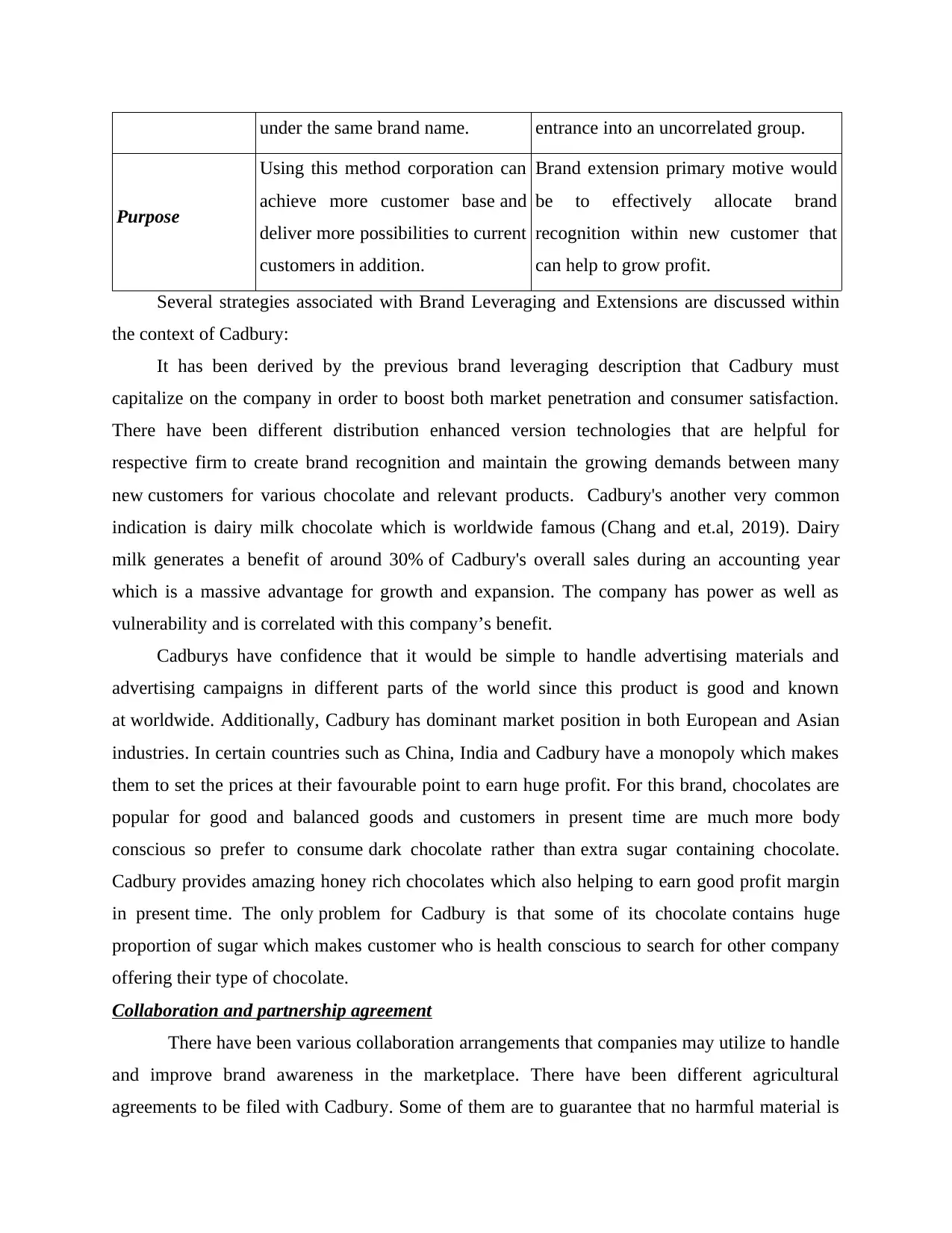
under the same brand name. entrance into an uncorrelated group.
Purpose
Using this method corporation can
achieve more customer base and
deliver more possibilities to current
customers in addition.
Brand extension primary motive would
be to effectively allocate brand
recognition within new customer that
can help to grow profit.
Several strategies associated with Brand Leveraging and Extensions are discussed within
the context of Cadbury:
It has been derived by the previous brand leveraging description that Cadbury must
capitalize on the company in order to boost both market penetration and consumer satisfaction.
There have been different distribution enhanced version technologies that are helpful for
respective firm to create brand recognition and maintain the growing demands between many
new customers for various chocolate and relevant products. Cadbury's another very common
indication is dairy milk chocolate which is worldwide famous (Chang and et.al, 2019). Dairy
milk generates a benefit of around 30% of Cadbury's overall sales during an accounting year
which is a massive advantage for growth and expansion. The company has power as well as
vulnerability and is correlated with this company’s benefit.
Cadburys have confidence that it would be simple to handle advertising materials and
advertising campaigns in different parts of the world since this product is good and known
at worldwide. Additionally, Cadbury has dominant market position in both European and Asian
industries. In certain countries such as China, India and Cadbury have a monopoly which makes
them to set the prices at their favourable point to earn huge profit. For this brand, chocolates are
popular for good and balanced goods and customers in present time are much more body
conscious so prefer to consume dark chocolate rather than extra sugar containing chocolate.
Cadbury provides amazing honey rich chocolates which also helping to earn good profit margin
in present time. The only problem for Cadbury is that some of its chocolate contains huge
proportion of sugar which makes customer who is health conscious to search for other company
offering their type of chocolate.
Collaboration and partnership agreement
There have been various collaboration arrangements that companies may utilize to handle
and improve brand awareness in the marketplace. There have been different agricultural
agreements to be filed with Cadbury. Some of them are to guarantee that no harmful material is
Purpose
Using this method corporation can
achieve more customer base and
deliver more possibilities to current
customers in addition.
Brand extension primary motive would
be to effectively allocate brand
recognition within new customer that
can help to grow profit.
Several strategies associated with Brand Leveraging and Extensions are discussed within
the context of Cadbury:
It has been derived by the previous brand leveraging description that Cadbury must
capitalize on the company in order to boost both market penetration and consumer satisfaction.
There have been different distribution enhanced version technologies that are helpful for
respective firm to create brand recognition and maintain the growing demands between many
new customers for various chocolate and relevant products. Cadbury's another very common
indication is dairy milk chocolate which is worldwide famous (Chang and et.al, 2019). Dairy
milk generates a benefit of around 30% of Cadbury's overall sales during an accounting year
which is a massive advantage for growth and expansion. The company has power as well as
vulnerability and is correlated with this company’s benefit.
Cadburys have confidence that it would be simple to handle advertising materials and
advertising campaigns in different parts of the world since this product is good and known
at worldwide. Additionally, Cadbury has dominant market position in both European and Asian
industries. In certain countries such as China, India and Cadbury have a monopoly which makes
them to set the prices at their favourable point to earn huge profit. For this brand, chocolates are
popular for good and balanced goods and customers in present time are much more body
conscious so prefer to consume dark chocolate rather than extra sugar containing chocolate.
Cadbury provides amazing honey rich chocolates which also helping to earn good profit margin
in present time. The only problem for Cadbury is that some of its chocolate contains huge
proportion of sugar which makes customer who is health conscious to search for other company
offering their type of chocolate.
Collaboration and partnership agreement
There have been various collaboration arrangements that companies may utilize to handle
and improve brand awareness in the marketplace. There have been different agricultural
agreements to be filed with Cadbury. Some of them are to guarantee that no harmful material is
Paraphrase This Document
Need a fresh take? Get an instant paraphrase of this document with our AI Paraphraser
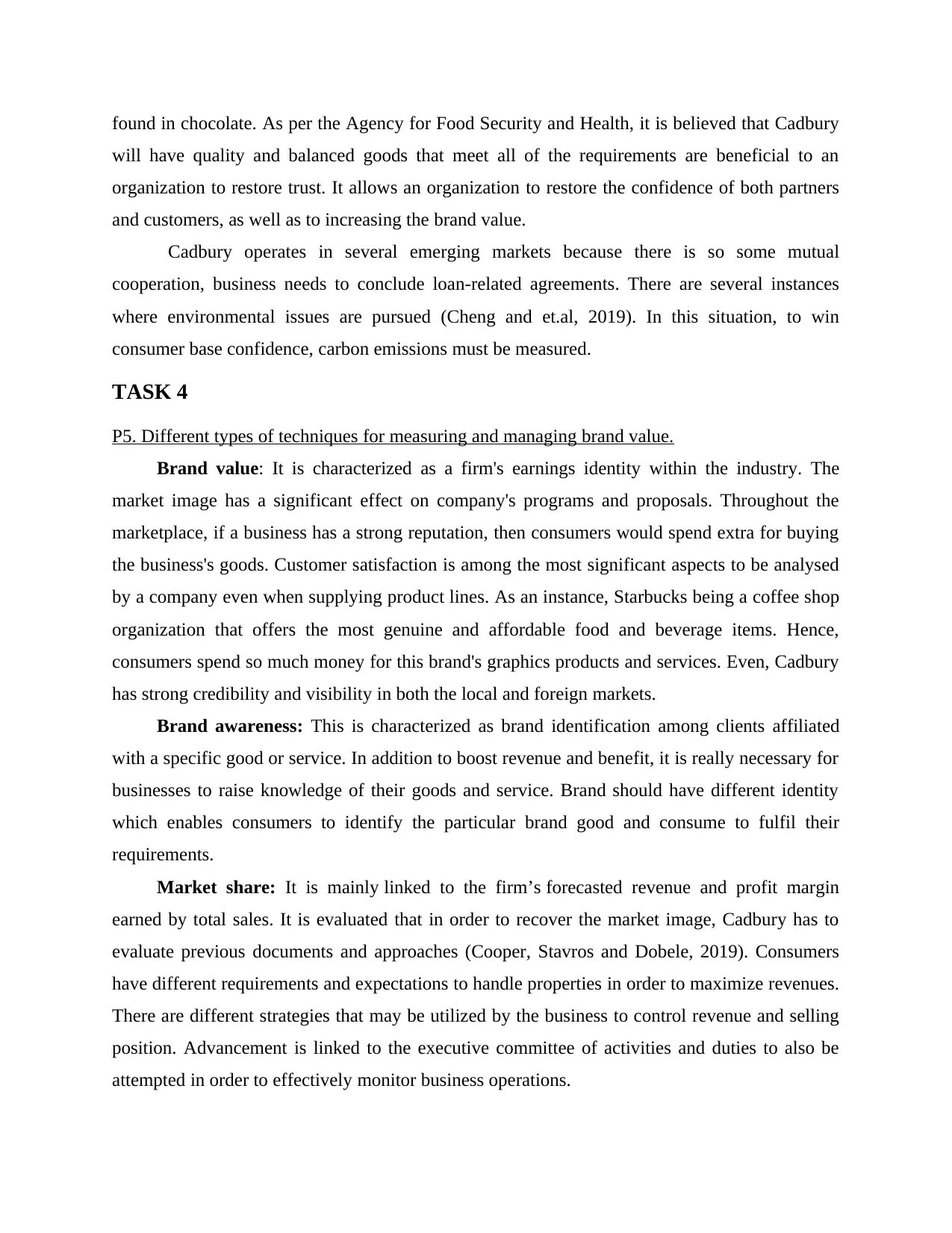
found in chocolate. As per the Agency for Food Security and Health, it is believed that Cadbury
will have quality and balanced goods that meet all of the requirements are beneficial to an
organization to restore trust. It allows an organization to restore the confidence of both partners
and customers, as well as to increasing the brand value.
Cadbury operates in several emerging markets because there is so some mutual
cooperation, business needs to conclude loan-related agreements. There are several instances
where environmental issues are pursued (Cheng and et.al, 2019). In this situation, to win
consumer base confidence, carbon emissions must be measured.
TASK 4
P5. Different types of techniques for measuring and managing brand value.
Brand value: It is characterized as a firm's earnings identity within the industry. The
market image has a significant effect on company's programs and proposals. Throughout the
marketplace, if a business has a strong reputation, then consumers would spend extra for buying
the business's goods. Customer satisfaction is among the most significant aspects to be analysed
by a company even when supplying product lines. As an instance, Starbucks being a coffee shop
organization that offers the most genuine and affordable food and beverage items. Hence,
consumers spend so much money for this brand's graphics products and services. Even, Cadbury
has strong credibility and visibility in both the local and foreign markets.
Brand awareness: This is characterized as brand identification among clients affiliated
with a specific good or service. In addition to boost revenue and benefit, it is really necessary for
businesses to raise knowledge of their goods and service. Brand should have different identity
which enables consumers to identify the particular brand good and consume to fulfil their
requirements.
Market share: It is mainly linked to the firm’s forecasted revenue and profit margin
earned by total sales. It is evaluated that in order to recover the market image, Cadbury has to
evaluate previous documents and approaches (Cooper, Stavros and Dobele, 2019). Consumers
have different requirements and expectations to handle properties in order to maximize revenues.
There are different strategies that may be utilized by the business to control revenue and selling
position. Advancement is linked to the executive committee of activities and duties to also be
attempted in order to effectively monitor business operations.
will have quality and balanced goods that meet all of the requirements are beneficial to an
organization to restore trust. It allows an organization to restore the confidence of both partners
and customers, as well as to increasing the brand value.
Cadbury operates in several emerging markets because there is so some mutual
cooperation, business needs to conclude loan-related agreements. There are several instances
where environmental issues are pursued (Cheng and et.al, 2019). In this situation, to win
consumer base confidence, carbon emissions must be measured.
TASK 4
P5. Different types of techniques for measuring and managing brand value.
Brand value: It is characterized as a firm's earnings identity within the industry. The
market image has a significant effect on company's programs and proposals. Throughout the
marketplace, if a business has a strong reputation, then consumers would spend extra for buying
the business's goods. Customer satisfaction is among the most significant aspects to be analysed
by a company even when supplying product lines. As an instance, Starbucks being a coffee shop
organization that offers the most genuine and affordable food and beverage items. Hence,
consumers spend so much money for this brand's graphics products and services. Even, Cadbury
has strong credibility and visibility in both the local and foreign markets.
Brand awareness: This is characterized as brand identification among clients affiliated
with a specific good or service. In addition to boost revenue and benefit, it is really necessary for
businesses to raise knowledge of their goods and service. Brand should have different identity
which enables consumers to identify the particular brand good and consume to fulfil their
requirements.
Market share: It is mainly linked to the firm’s forecasted revenue and profit margin
earned by total sales. It is evaluated that in order to recover the market image, Cadbury has to
evaluate previous documents and approaches (Cooper, Stavros and Dobele, 2019). Consumers
have different requirements and expectations to handle properties in order to maximize revenues.
There are different strategies that may be utilized by the business to control revenue and selling
position. Advancement is linked to the executive committee of activities and duties to also be
attempted in order to effectively monitor business operations.
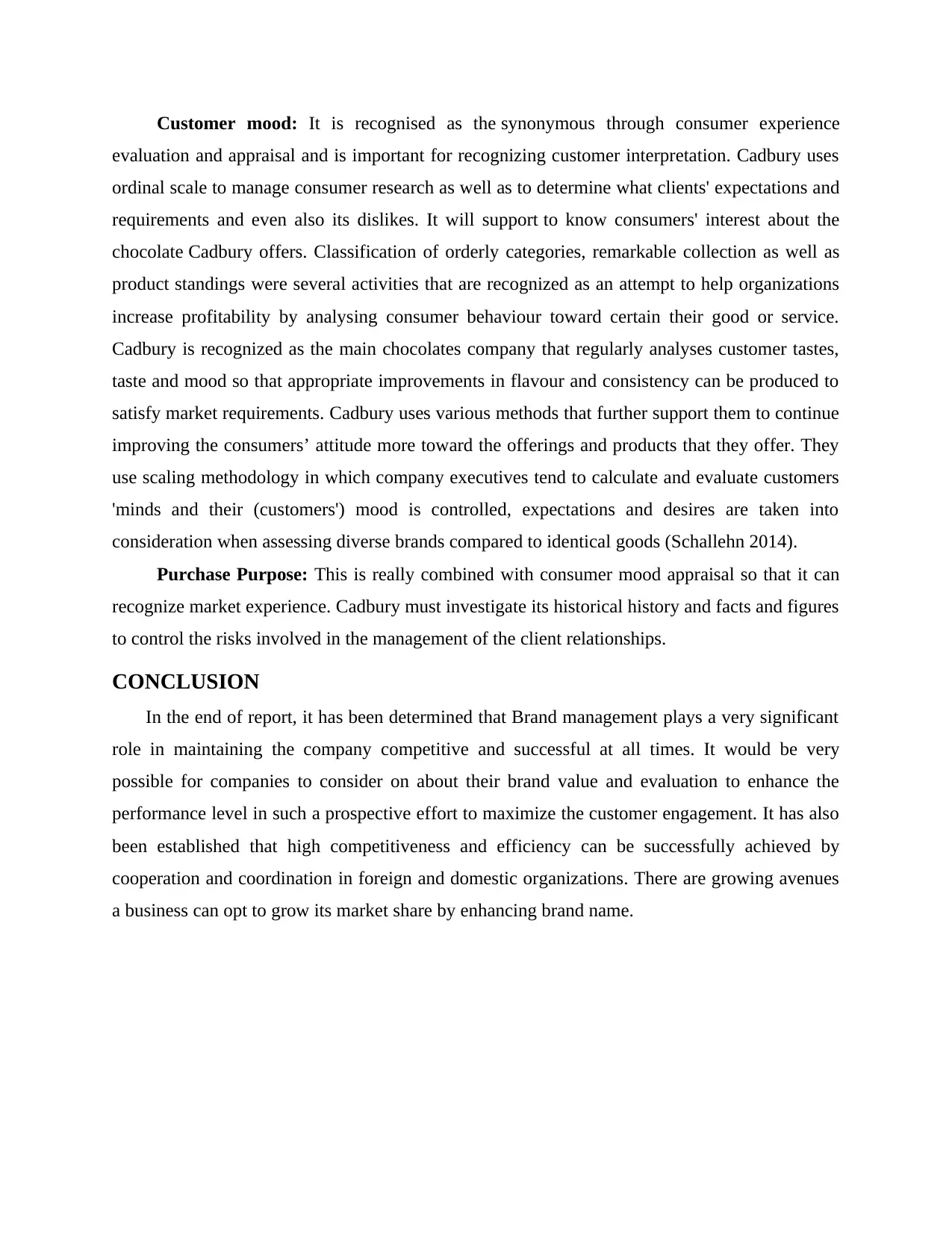
Customer mood: It is recognised as the synonymous through consumer experience
evaluation and appraisal and is important for recognizing customer interpretation. Cadbury uses
ordinal scale to manage consumer research as well as to determine what clients' expectations and
requirements and even also its dislikes. It will support to know consumers' interest about the
chocolate Cadbury offers. Classification of orderly categories, remarkable collection as well as
product standings were several activities that are recognized as an attempt to help organizations
increase profitability by analysing consumer behaviour toward certain their good or service.
Cadbury is recognized as the main chocolates company that regularly analyses customer tastes,
taste and mood so that appropriate improvements in flavour and consistency can be produced to
satisfy market requirements. Cadbury uses various methods that further support them to continue
improving the consumers’ attitude more toward the offerings and products that they offer. They
use scaling methodology in which company executives tend to calculate and evaluate customers
'minds and their (customers') mood is controlled, expectations and desires are taken into
consideration when assessing diverse brands compared to identical goods (Schallehn 2014).
Purchase Purpose: This is really combined with consumer mood appraisal so that it can
recognize market experience. Cadbury must investigate its historical history and facts and figures
to control the risks involved in the management of the client relationships.
CONCLUSION
In the end of report, it has been determined that Brand management plays a very significant
role in maintaining the company competitive and successful at all times. It would be very
possible for companies to consider on about their brand value and evaluation to enhance the
performance level in such a prospective effort to maximize the customer engagement. It has also
been established that high competitiveness and efficiency can be successfully achieved by
cooperation and coordination in foreign and domestic organizations. There are growing avenues
a business can opt to grow its market share by enhancing brand name.
evaluation and appraisal and is important for recognizing customer interpretation. Cadbury uses
ordinal scale to manage consumer research as well as to determine what clients' expectations and
requirements and even also its dislikes. It will support to know consumers' interest about the
chocolate Cadbury offers. Classification of orderly categories, remarkable collection as well as
product standings were several activities that are recognized as an attempt to help organizations
increase profitability by analysing consumer behaviour toward certain their good or service.
Cadbury is recognized as the main chocolates company that regularly analyses customer tastes,
taste and mood so that appropriate improvements in flavour and consistency can be produced to
satisfy market requirements. Cadbury uses various methods that further support them to continue
improving the consumers’ attitude more toward the offerings and products that they offer. They
use scaling methodology in which company executives tend to calculate and evaluate customers
'minds and their (customers') mood is controlled, expectations and desires are taken into
consideration when assessing diverse brands compared to identical goods (Schallehn 2014).
Purchase Purpose: This is really combined with consumer mood appraisal so that it can
recognize market experience. Cadbury must investigate its historical history and facts and figures
to control the risks involved in the management of the client relationships.
CONCLUSION
In the end of report, it has been determined that Brand management plays a very significant
role in maintaining the company competitive and successful at all times. It would be very
possible for companies to consider on about their brand value and evaluation to enhance the
performance level in such a prospective effort to maximize the customer engagement. It has also
been established that high competitiveness and efficiency can be successfully achieved by
cooperation and coordination in foreign and domestic organizations. There are growing avenues
a business can opt to grow its market share by enhancing brand name.
⊘ This is a preview!⊘
Do you want full access?
Subscribe today to unlock all pages.

Trusted by 1+ million students worldwide
1 out of 14
Related Documents
Your All-in-One AI-Powered Toolkit for Academic Success.
+13062052269
info@desklib.com
Available 24*7 on WhatsApp / Email
![[object Object]](/_next/static/media/star-bottom.7253800d.svg)
Unlock your academic potential
Copyright © 2020–2025 A2Z Services. All Rights Reserved. Developed and managed by ZUCOL.



